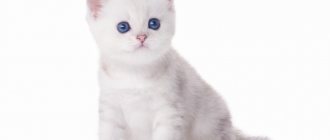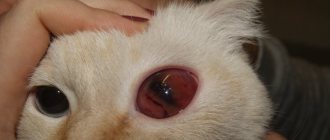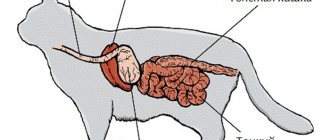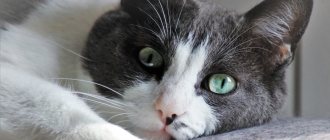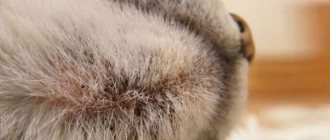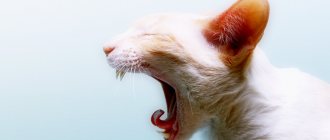Every owner should know the symptoms and treatment of intestinal atony in cats. Intestinal atony in cats is not a rare disease in which insufficient tone of the smooth or transverse muscles of the intestine is detected, which disrupts the digestion process and the animal begins to have health problems.
This phenomenon is caused not by overeating or undereating, as many owners believe, but by a deficiency of fiber in the animal’s diet. Because of this, the intestinal receptors do not receive the necessary irritation and begin to work incorrectly. As a result, initially there is a serious weakening of intestinal motility, which subsequently leads to its complete stop and the appearance of obstruction. As a result of this violation, a plug begins to form in the intestines, which poses a direct threat to the life of the pet.
© shutterstock
Causes of pathology
Atony in cats develops due to a weakening of the intestinal muscles and a decrease in the activity of digestive processes with a gradual increase in the difficulty of defecation.
Veterinarians identify the main causes of the disease:
- hereditary predisposition;
- congenital disorders of intestinal development and formation in kittens;
- natural aging of the body and weakening of muscles;
- diseases of the endocrine system;
- improper feeding;
- blockage of intestines with fur;
- lack of fiber in food;
- low physical activity;
- intestinal infections;
- extensive helminth infestation;
- malignant neoplasms;
- overfeeding, obesity;
- inflammatory diseases of the stomach.
Failure to comply with pet hygiene rules can cause illness.
The following factors have additional adverse effects:
- adhesions as a result of surgery;
- taking and side effects of medications;
- psychological tension and stress;
- a dirty litter tray and the cat’s reluctance to empty itself;
- decreased intestinal vascular tone.
Answers to questions from an online veterinarian. Free consultations
Should the doctor replace it with something? We are afraid that the cat will not live to see the end of the course....Thank you
↓↓0↑↑ Elena (-9 / 3) July 27, 2014 23:43 »»
Hello, Elena. Very similar to an overdose, which leads to a strong increase in the tone of the smooth muscles of the internal organs. It is urgent to discuss with your veterinarian the possibility of taking another anticholinesterase drug or reducing the dosage of proserin. It must be said that adequate dosage is of decisive importance.
We invite you to read: How cats are sterilized - details about the operation
Insufficient - has no effect, and high can lead to serious consequences. If you suspect that your cat has any pain, you should not give it Proserin until the pain syndrome is relieved (in the acute phase of the disease, the drug is strictly contraindicated). By the way, the drug injections themselves are very painful.
↓↓0↑↑ Orlova Svetlana Arkadyevna (1557 / 2266) July 28, 2014 08:52 ““#2”” Reply
you know, although I’m not a doctor, I intuitively understood that she was getting worse and worse with each injection (!), especially since there were from 5 to 6 of them at a time (decamethasone 1.0, riboxin 1.0, pirocetam 1.0, thiotriazoline 1.0, proserin 0.3 (reduced only on the 5th day from 0.5 mg!), glucose 5% 20.0 This is a prescription for injections on the 8th day of treatment - the day of her death…….
(and the diagnosis was already not myelopathy, but encephalopathy) all that day she was throwing around from pain and convulsions (the injections were given by 17.00) the cat was in great pain, screaming, severe convulsions... I thought that I would lose consciousness from her torment... if we were still on July 27 and 26 They injected her at 11.00 (like the whole course from July 21), then by the evening she felt at least a little better, she at least somehow reacted to us and even ate well (until July 26).
Do you know that the most interesting thing all started with the fact that she was limping on her leg, and seemed to be clinging to the floor with her claws, slightly... (it was like this for 2 weeks, we waited, maybe it would get better, you never know) But no, so we went to doctor, we were prescribed this course (listed above, plus or minus some injections were changed) AND IMMEDIATELY THE NEXT.
THAT DAY SHE WASN’T ABLE TO GET UP, at first she crawled, and by the evening she was already rolling around, after a couple of days she was lying almost all the time... well, then you know (ps. the picture of the spine was excellent)... we were crying a lot 28.07 by 20.15 she was gone, I didn’t even have time to call intensive care... because the pulse was 34 beats... it was easily visible and palpable on the neck....
I saw my husband cry for the first time...she was only 1 year and 11 months...Perhaps our experience can save other beloved pets...P.S.: we did not have time to read your answer...although we consulted with more than 5 veterinarians , everyone unanimously approved of such treatment....is this illiteracy???or heartlessness...
↓↓0↑↑ Elena (-9 / 3) July 30, 2014 00:06 ““#3”” Reply
I will decide for myself what is necessary and what is not - it is not sensitive on your part. But not everyone manages to find an adequate doctor with adequate treatment on time!
↓↓−9↑↑ Elena (-9 / 3) July 31, 2014 20:56 ““#5”” Reply
I couldn’t pass by. How shameless of you. They try to help you, give you advice, but you answer ungratefully with jargon, one might say show off. It’s wiser to pass by if you don’t like it. People spend time on us, invest their souls. It's no one's fault that this happened. I am very sorry about what happened to the cat, I love animals very much. PS: It would be nice to improve your grammar. Good and healthy.
↓↓ 5↑↑ Giorgio Armani (12 / 47) 01 Aug 2014 04:14 ““#6 Reply
Atony in cats is a disease that is characterized by a lack of normal tone of the skeletal muscles or internal organs, which leads to disruption of their normal functioning.
With this pathology in animals, muscle elements stop contracting vigorously. Despite the fact that this disease is not common in veterinary practice, without normal contraction of smooth or striated muscles, like any other living beings, they cannot move normally, obtain food on their own, or perform many other actions.
Symptoms of the disease
A decrease in the activity of the intestines and stomach in cats is manifested by disruption of digestive processes and a further deterioration of the general condition. Main symptoms of atony:
- decreased appetite;
- vomit;
- decreased intestinal motility;
- significant reduction in feces excreted;
- change in consistency and addition of an unpleasant odor from feces;
- weakness, lethargy.
One of the symptoms of the disease is a significant increase in the abdominal cavity.
Obstruction in cats causes the following symptoms:
- abdominal tension;
- lack of appetite, refusal of any food;
- sagging abdomen;
- weight loss;
- deterioration of coat condition;
- blanching of mucous membranes;
- aggressive reaction when touching the stomach due to pain.
What are the guts of a domestic cat?
I want to come here Olga, 58 Surgut, Russia Lilia, 55 St. Petersburg, Russia Svetlana, 42 Moscow, Russia Anyuta, 29 Chelyabinsk, Russia Irina, 59 Kazan, Russia Pavel, 40 Voronezh, Russia Elena, 40 St. Petersburg, Russia Natalya Zaikina, 44 Moscow, Russia Vyacheslav, 35 Mos kwa , Russia Victoria, 32 Moscow, Russia Maria, 45 Kirov (Kirov region), Russia Kot, 40 Moscow, Russia IVAN, 33 Moscow, Russia Dmitry, 27 Belgorod, Russia Dmitry, 46 Abakan, Russia Andrey, 37 Podolsk, Russia Habib, 31 St. Petersburg, Russia Alexander , 32St. Petersburg, Russia Alexander, 50Novosibirsk, Russia lilit, 59Riga, Latvia Dmitry, 36Moscow, Russia Mila, 34Moscow, Russia Victor, 29Moscow, Russia Daniil, 27Moscow, Russia
Diagnostics
To determine treatment tactics, it is necessary to find out the cause of atony. A veterinarian performs a visual examination of the cat with palpation of internal organs. The diagnosis is based on pathological history, laboratory and instrumental diagnostic methods. Basic laboratory tests:
- Blood chemistry. A detailed study of the work of internal organs.
- Coprogram. Stool analysis assessing the functioning of the digestive and excretory systems and the presence of parasites.
Instrumental diagnostics includes the following examinations:
- Radiography. The organs of the gastrointestinal tract and intestinal structures are visualized.
- Ultrasound diagnostics (ultrasound). Checking the condition and contents of internal organs.
- X-ray with contrast. The work of the intestines is examined one by one after the administration of barium sulfate (jejunum, cecum and colon after 4-6 hours, rectum after 7).
- Diagnostic laparotomy. A surgical intervention that identifies damage to the digestive organs through an incision in the abdominal wall.
Treatment of pathology
After examination and medical history, the specialist selects a treatment method.
The choice of methods for treating intestinal atony in cats depends on the cause of defecation difficulties, the duration and severity of manifestations, the age of the animal and concomitant diseases. The veterinarian chooses from the following treatment methods:
- therapeutic nutrition;
- administering enemas with an antiseptic;
- administration of medications;
- surgical intervention.
The therapeutic diet is based on enriching the diet with fiber to stimulate digestive processes and irritate intestinal receptors. The veterinarian selects the appropriate ready-made food in accordance with the clinical picture. If the cat has eaten natural food, the doctor draws up a menu for the treatment period. Additional gentle means to facilitate bowel movements are:
- specially grown medicinal herbs (sold at a veterinary pharmacy);
- Vaseline oil;
- fiber in the form of dietary supplements.
The main means of therapy and their effects are presented in the table:
| Group of drugs | Therapeutic effect |
| Prokinetics | Stimulates intestinal contractions |
| Strengthens the functioning of the excretory system | |
| Laxatives | Liquefies feces |
| Increase intestinal activity | |
| Gastroprotectors | Protects the gastric mucosa |
| Increases resistance to external irritants | |
| Probiotics | Restore intestinal microflora |
| Antispasmodics | Remove spasms |
| Antibiotics | Eliminate infectious pathogens |
| Analgesics | Relieves pain |
| Anthelmintic | Destroy and remove parasites |
In some cases, the only treatment option is surgery.
If atony in cats is caused by fecal stones, malignant neoplasms, congenital malformations of the excretory system, or the intestines are clogged with helminths, surgical intervention is performed to eliminate the negative factors that interfere with the natural process of defecation.
Why does a cat swallow objects?
Experienced breeders and veterinarians know that most often the penetration of foreign bodies occurs through the digestive tract. Curious cats, playing with various objects that come into their field of vision, often swallow them. Especially often, during the operation, veterinarians discover caps from valerian, parts of children's construction sets, coins, construction waste, and burst balloons.
The peak of calls regarding animals swallowing a foreign object usually occurs during the New Year holidays. Bright tinsel, small Christmas tree decorations, parts of garlands, and Christmas tree decorations attract the attention of curious cats with their shine and rustle.
Furry couch potatoes are partial to handicraft items (threads, needles, buttons, decorative elements) and fishing gear (line, hooks, spoons, wobblers, etc.).
The risk group includes small kittens and young animals. Due to natural curiosity and lack of life experience, young animals try new objects and often swallow them. Animals left to their own devices for a long time are also at risk. A bored cat tries to entertain itself by playing with foreign objects. Veterinarians also consider hair balls in a cat's stomach to be a dangerous foreign body.
Veterinary experts strongly recommend that owners who discover that a cat has swallowed a foreign body not take any independent action. Lack of professional skills and knowledge will lead to even more severe consequences for the pet’s health.
For example, you should not give petroleum jelly, which can cause intussusception when a foreign body is in it. Under no circumstances should you induce vomiting if there is a suspicion that a sharp object, alkali or petroleum product has been swallowed.
The owner must ensure that the animal does not take food or water before visiting the veterinarian, provide the cat with complete rest and urgently take it to a specialized clinic.
| It is unlikely that anyone will argue with the fact that the importance of muscles in the body of an animal or a person is enormous. Only through muscle tissue can we move in space, get our own food, and perform many other actions. Oddly enough, many people understand the word “muscle” exclusively as skeletal muscle, although the role of this tissue in the body is much more extensive. Atony “helps” to remember this: in cats, this disease does not occur very often, but whenever it appears, it still causes a lot of problems both for the animal itself and for its owners. |
Prevention of atony
To prevent difficulties in the digestive system and bowel movements, veterinarians at various clinics recommend that the cat owner follow the following rules:
- Feed the animal with high-quality feed or products.
- Ensure the supply of all necessary nutrients.
- Avoid hypothermia and stressful situations to normalize the animal’s psycho-emotional state.
- Be sure to play with your cat to increase muscle tone and physical health.
- Maintain cleanliness of the pet's premises and personal belongings.
A prerequisite for maintaining the health and well-being of a cat is the regularity and timeliness of preventive examinations, vaccinations and deworming. If negative symptoms occur, it is important to seek professional help and treat any underlying conditions.
